How to build a multi-vendor marketplace
To build a multi-vendor marketplace, you don’t need to set up plugins or know how to code. Here’s the complete guide to starting a successful marketplace business.
E-commerce is growing, and marketplaces are taking a bigger share of the sector. Global e-commerce sales reached about $5.8 trillion in 2023, and they’re estimated to surpass $8 trillion by 2027.
Meanwhile, marketplaces accounted for nearly 30% of global online purchases in 2024. And they’re not stopping anytime soon. Third-party sales through marketplaces are expected to become the largest and fastest-growing retail channel globally by 2027, accounting for 59% of all global e-commerce.
Simply put, the multi-vendor marketplace model carries a lot of potential.
Marketplaces are phenomenal businesses. The success of platforms like Amazon, Airbnb, and Uber has shown that the multi-vendor model can be tremendously effective and incredibly scalable.
At the same time, building a marketplace business is much more complicated than launching a traditional e-commerce store. A marketplace has to work for both sides: sellers and buyers. Getting the business model off the ground requires time, effort, and iteration.
Creating a marketplace website is also much harder than setting up an e-commerce store. The leading marketplaces employ thousands of engineers. A startup founder rarely has the resources to make such an investment in the early days.
Luckily, today’s marketplace founders have options.
Many no-code and low-code solutions give you the essential marketplace functionality at a fraction of the time and cost of developing a marketplace from scratch. At Sharetribe, we offer founders a fully functional no-code marketplace builder that can be infinitely extended with custom code—without the need to install plugins and extensions.
Still, technology is just one piece of the puzzle. To succeed, you need to understand how the multi-vendor marketplace model works—what makes it valuable, where it’s challenging, and how to bring it to market. That’s exactly what this guide will help you do.
Multi-vendor marketplaces are platforms where people can exchange goods and services. They connect buyers with many individual sellers.
Sellers on marketplaces make money by listing and selling their items on the marketplace, and the marketplace platform makes money by charging a fee for each transaction.
The most popular examples are Amazon, Alibaba, and eBay. They all focus on retail.
However, marketplaces thrive in many other types of markets. Here are several examples:
- Product marketplaces like Etsy, Poshmark, and StockX, which focus on a specific product type or category
- Rental marketplaces like Airbnb, VRBO, and Turo
- Service marketplaces like Upwork, Fiverr, and Thumbtack
The marketplace model has become successful for several key reasons. But first, let’s examine the fundamental difference between a multi-vendor marketplace and a traditional e-commerce store.
Multi-vendor websites (sometimes also called "e-commerce marketplaces") are very different from regular e-commerce stores because they are two-sided.
A regular e-commerce founder is their only vendor (or seller), solely responsible for sourcing, pricing, and shipping the items they sell. Their e-commerce website caters to one audience group: their customers (or buyers). For this model, traditional e-commerce software solutions—like Shopify or WooCommerce—are typically sufficient, as they’re built to support a single seller’s operations.
A marketplace founder, on the other hand, has two audience groups to consider: the buyers and the sellers. The sellers on the marketplace are responsible for creating, pricing, and delivering the goods or services sold. The marketplace’s job is to connect the sellers and buyers and offer them a secure platform to make transactions.
This core difference means multi-vendor websites require entirely different features from traditional e-commerce sites. This impacts user profiles, reviews, online payment systems, and admin panels—features that traditional e-commerce builders like Shopify or Magento typically don’t support out of the box.
Marketplaces run on a completely different business model, too. When a customer makes a payment on a marketplace, most of the money goes to the seller. A marketplace usually makes money by charging a small fee for every transaction within the platform, often called a commission.
Because the audience, platform, and business model are so different, the strategies for building, launching, and growing a marketplace differ from those for starting an e-commerce store. At the same time, the multi-vendor model brings unparalleled benefits to both sides of the market and the marketplace founder.
Marketplaces connect supply (sellers) with demand (buyers). The website acts as a trusted platform for transactions to take place and usually charges some form of commission on every successful transaction.
This model offers considerable benefits for all parties involved: buyers, sellers, and entrepreneurs.
Marketplaces remove a lot of the friction from the buying process, making it easier, faster, and cheaper for buyers to get what they want. With well-established marketplace platforms, buyers also benefit from increased choice and can be confident in their purchases due to features like ratings, reviews, and profiles.
Let’s look at a real-life example, our customer, The Octopus Club.
The Octopus Club is a marketplace for buying and selling pre-loved children’s clothes and other items. Before Ana Rachel Estrougo founded the platform, she found it difficult to find high-quality, pre-owned clothes for her rapidly growing child.

For customers, buying things new is not always the desired option. It’s expensive and not sustainable in the long run. But when Ana tried to buy secondhand, she couldn’t find a place that felt trustworthy. She wanted a place where she could be sure things would arrive clean or that they had been well kept.
The Octopus Club succeeded in solving these problems for the buyers. It became an online marketplace for parents to buy high-quality children’s clothing, toys, and accessories. Ultimately, her business fostered a community of like-minded parents passing beloved items around.
It’s not just buyers who benefit from the multi-vendor model—sellers do too. In fact, providing benefits to sellers should be a top priority for marketplaces: without them, there is no platform.
The primary benefit for sellers is access to a large group of customers. Any arts or crafts business could set up its own website and sell to customers. But why do that when they could list their products on Etsy and sell directly to Etsy’s 82 million active buyers?
On the other hand, smaller niche websites with very targeted audiences can also offer significant business benefits for sellers. Again, The Octopus Club is a great example. Kids grow up fast, and clothes, accessories, and toys pile up. Selling them on The Octopus Club lets parents pass on high-quality items that will make the next owner happy for extra cash, with the added benefit of knowing they’re contributing to a more sustainable future.
On a multi-vendor marketplace, sellers gain access to built-in buyer traffic without the overhead of managing their own storefront or running paid campaigns. These platforms act like digital malls, where customers are already browsing and ready to buy. For sellers, this means lower customer acquisition costs and increased discoverability, especially in niche marketplaces with loyal, targeted audiences.
In addition to exposure to bigger or more targeted audiences, many marketplaces also offer sellers better tools to manage their business. For example, marketplaces offer a centralized infrastructure that handles everything from payments to order processing and support. Many also include seller dashboards, inventory management tools, and dispute resolution systems. This all-in-one setup reduces the technical and logistical burden so they can focus on what they do best: offering great products or services.
All in all, marketplaces represent a huge growth opportunity for sellers. A well-run marketplace gives birth to hundreds, if not thousands, of businesses, creating economic security for sellers, their families, and their employees.
Marketplaces are attractive businesses for entrepreneurs. The costs of starting up have become much lower after the emergence of marketplace software. No-code builders make it easy to launch your site even without coding skills.
However, the biggest benefit for entrepreneurs by far is the possibility of network effects.
Network effects boost a marketplace’s growth. When a platform has network effects, its value grows in line with the number of people who use it. An increase in sellers increases selection and price competition, which helps bring more buyers to the platform. More buyers mean more business for the sellers, so more sellers join the platform.
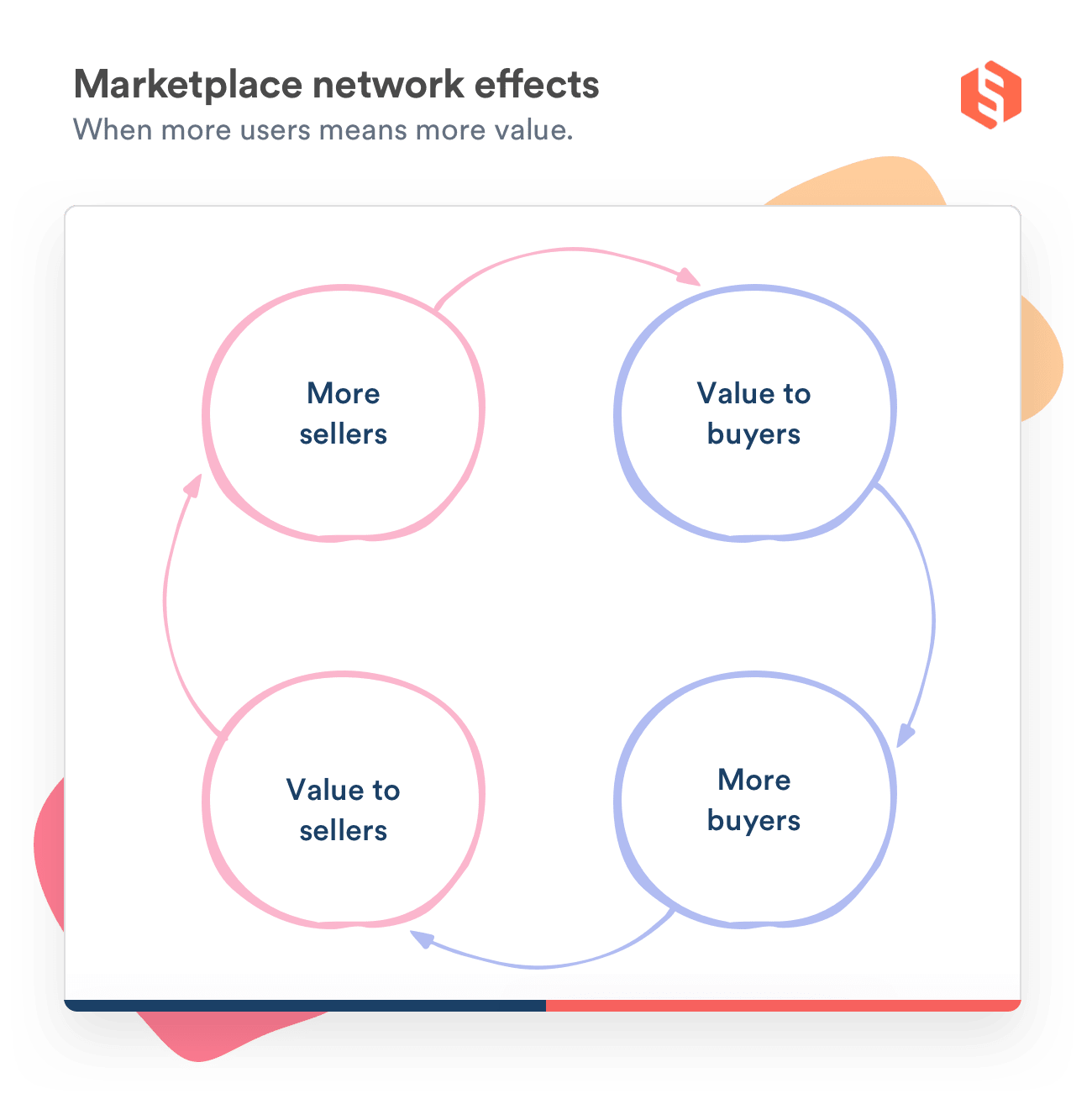
Entrepreneurs can also leverage buyer-seller overlap and cross-side virality to boost the network effects on their platforms. Cross-side virality occurs when getting a new seller to join the platform also brings you new customers. If a part of those customers also turns into providers, you have a significant growth opportunity on your hands.
Our customer, The Nold, is a great example. It’s a fashion marketplace where both individual sellers and brands can create their own fashion resale hubs. A high-quality seller, such as a fashion blogger, style influencer, or a coveted brand, with a big selection of exclusive items to list, joins the platform. They also bring an existing audience, such as their social media followers or customers from a previous platform. Some of the audience likely have their own fashion items to sell. They first discover The Nold as buyers, then list their own items and bring in their existing audiences—and on and on it goes.

Network effects attract marketplace entrepreneurs because they can significantly speed up scaling the business while reducing customer acquisition costs.
As new users join, the platform’s value increases for all users, which means that the entrepreneur can charge a higher commission from sellers. This loop continues infinitely. And multi-vendor marketplaces that master it can achieve phenomenal scale.
Another big advantage is that marketplaces have several monetization options, unlike traditional e-commerce businesses that rely solely on product margins. Here are some examples:
- Transaction fees (also known as commission)
- Listing fees
- Subscription plans
- Freemium tiers
- Advertising
- Value-added services like insurance or fulfillment
This diversification helps reduce risk and allows you to tailor your pricing to your market’s needs. You can even test different models at different stages: start with low-friction options like commission to attract early users, then layer in additional revenue streams as your platform grows. This flexibility gives you room to evolve your business over time.
Building a multi-vendor website is hard—much harder than starting an e-commerce store. Network effects are a powerful growth lever, but getting things up and running means overcoming some challenges nearly all early-stage marketplace entrepreneurs face. These include solving the chicken-or-egg problem, achieving liquidity, and building trust.
What comes first, buyers or sellers? Buyers will be attracted to marketplaces with many sellers, and sellers will be attracted to sites with many buyers. When you create a multi-vendor business, you need both sides.
Our advice: First, focus on bringing an initial group of sellers on board, then recruit buyers. There are many ways to overcome this problem. To learn more, check out our proven tactics to solve the chicken-or-egg problem.
Building a multi-vendor marketplace is almost like building two individual businesses. You need different strategies for bringing in sellers and buyers. You also need to retain them by ensuring that a seller will likely find customers and make money—and that potential buyers will likely find what they’re looking for.
This is called liquidity. If an individual user is likely to reach their goal on your marketplace, you’ve reached a good level of liquidity.
Liquidity is arguably the single most important marketplace metric. The best way to achieve liquidity is to focus on a small niche. And expand when (and only when) your business starts to become successful in the first niche.
Consider focusing on one geographic area and then expanding into new markets. Numerous successful marketplaces, from Uber to TaskRabbit, have followed this playbook.
For a marketplace to be successful, buyers and sellers must have trust. Both in each other and in the platform.
Establishing trust is hard for any new business, but even more so for marketplaces. Buyers might be spending a lot of money, and sellers could be sharing valuable assets like their homes (Airbnb) or cars (Turo).

Entrepreneurs can implement a wide variety of strategies to build trust between their users. Some, like reviews and profiles, are relatively simple, whereas others, like handling payments, can be much more complicated.
As your marketplace grows, so does the complexity of managing sellers. Ensuring quality across a growing vendor base means enforcing standards, monitoring performance, and providing responsive support. When something goes wrong, like a late shipment, poor customer service, or even fraud, buyers often blame the marketplace, not the individual seller.
Establish clear onboarding processes, seller guidelines, and feedback systems early on. In an interview with Sharetribe, Shelby Clark, founder of Turo, says that prioritizing quality supply from the start builds long-term trust. Poor early experiences can permanently erode your reputation and hurt retention.
Your marketplace’s technical foundation needs to grow with your business. What works for 10 sellers and a handful of users may break under the pressure of thousands of listings, transactions, and support requests. Without scalable infrastructure, marketplaces often encounter issues like slow load times, failed payments, or admin bottlenecks. These problems directly impact user trust and conversion.
To avoid having to deal with technical issues as your business grows, choose a platform built for scale from day one. Sharetribe’s architecture is designed to grow with your marketplace, so you’ll never need to re-platform. Whether you have 10 users or 10 million, your infrastructure stays reliable.
As your needs evolve, Sharetribe’s developer platform lets you add custom features or automate operations using code, on top of your existing no-code foundation. This hybrid approach gives founders complete flexibility without compromising speed or stability.
Learn more in our guides on choosing marketplace software and growing your marketplace on a budget.
Each marketplace category requires its own set of features. There are a few ways to determine what type of website you should create. Consider what your vendors are selling on your site, who they’re selling to, and how they’re selling.
Let’s explore the different types of multi-vendor marketplaces and the different features that they require.
The type of product, service, or rental vendors will sell on your marketplace should drive many of your feature and design decisions. Let’s explore the most common models.
Product marketplaces are perhaps the best-known type of multi-vendor site. The most well-known include platforms like Etsy and eBay, but many start by offering products in a particular niche. Examples include The Octopus Club and Handmade.com.
Although the exact details will vary, most multi-vendor product marketplaces require several distinct features:
- Seller profiles
- Product listing pages
- Reviews
If you want to process payments on the platform (like all the examples mentioned above), you also need a marketplace payment solution compliant with regulations. “Online mall” types of B2C product marketplaces like Amazon also need a multi-vendor shopping cart.
Rental marketplaces let buyers rent various things from sellers. The most popular example is Airbnb, but many different things can be rented. For instance, Sharetribe customer Swimmy helps people rent swimming pools, while Studiotime helps musicians rent studios.
Necessary features include:
- Booking calendar
- Messaging interface
- Reviews
- Location services
However, features like a shopping cart or inventory management aren’t as relevant.
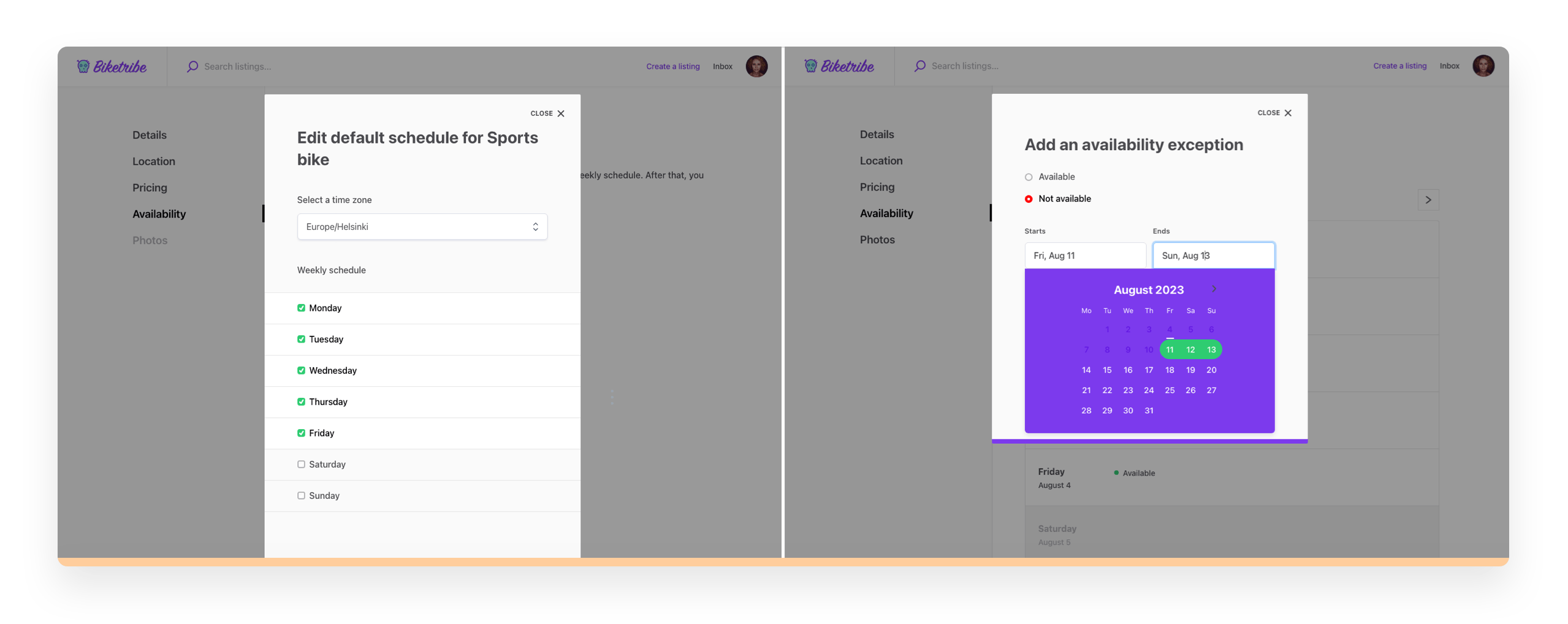
Service-based marketplaces allow buyers to hire sellers to help them with tasks. These could be anything from professional services (like graphic design, construction, or cleaning services) to shorter-term tasks like dog walking.
The largest global service marketplaces include Fiverr and Upwork, but many successful niche marketplaces exist, including Sharetribe customer Freedomly.
Similar to rental-based sites, these platforms need:
- Booking calendars
- Location-based searches
- User profiles
- Ratings and reviews
What your website sells isn’t the only factor that determines the features you need. It’s also the audience that you plan on marketing your platform to. There are three different types of audiences:
- Peer-to-peer (P2P) or consumer-to-consumer (C2C): Audiences on P2P marketplaces value simplicity, security, and streamlined design. Include profiles, two-way reviews, and simple, secure payments.
- Business-to-consumer (B2C): If you work with business sellers, give them all the professional tools they need to manage their business.
- Business-to-business (B2B): B2B marketplaces require extensive custom functionality, including complicated transaction flows, contracts, and reporting tools.
How you want sellers and providers to communicate will impact your feature requirements.
The standard marketplace flow is the most common. Users go through the motions relatively similarly, whether it’s on a P2P site like Airbnb, a B2C marketplace like Amazon, or a B2B/B2C platform like Fiverr. Customers enter the site and browse listings. After finding what they want, they initiate a transaction by making a booking, purchasing an item, or contacting the seller.
A reverse flow is also possible. On marketplaces like Upwork or Airtasker, buyers can browse sellers’ profiles and contact the most promising candidates. Or they can post a job and ask sellers to provide quotes.
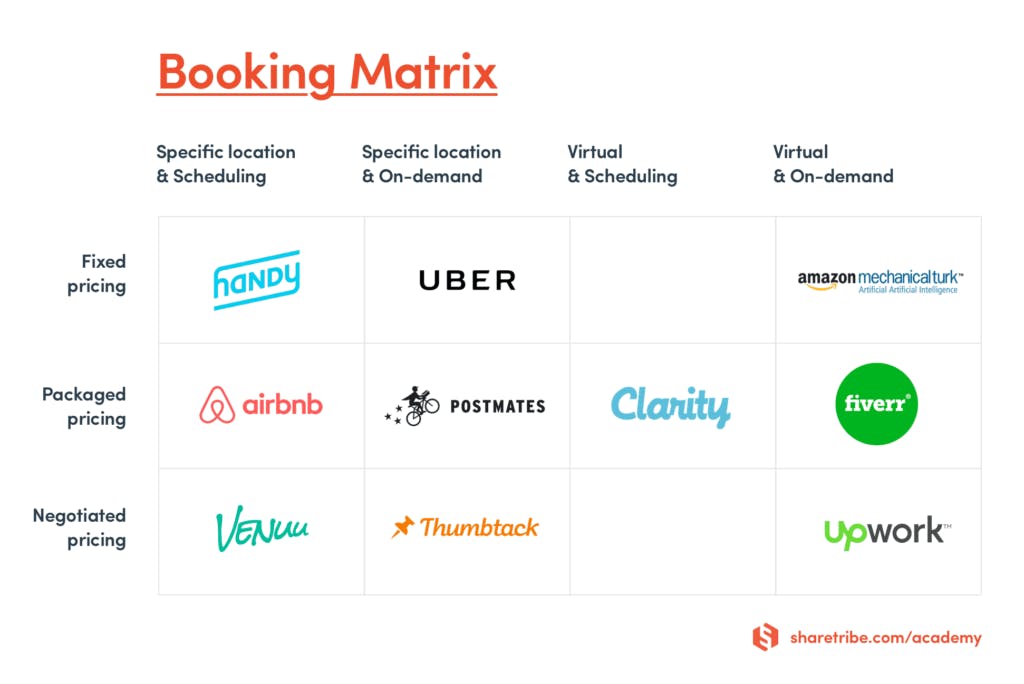
Of course, there are a lot of smaller things to consider in your booking flow. Here are some other questions to consider:
- Are prices fixed or negotiated?
- Are bookings scheduled, or can they happen on demand?
- Do sellers and buyers need to be verified?
- Do sellers and/or buyers need to sign contracts or NDAs?
The most successful marketplaces start small. Some of the world’s biggest platforms—like Etsy and Airbnb—began as niche marketplaces before they became global brands.
Instead of trying to serve everyone, they focus on a specific audience, use case, or category. A well-defined niche helps you stand out and makes it easier to build early traction by solving a specific problem for a clearly defined group of people.
Look for underserved or inefficient markets where buyers and sellers struggle to connect. Explore industry forums, Reddit threads, and keyword trends. Study existing marketplaces, and ask yourself: What do they lack? Who are they not serving well?
Then use surveys, interviews, and waitlists to gather feedback and validate demand. Landing pages, pre-orders, or simple “concierge MVPs” (where you manually facilitate transactions) are all valuable ways to test real-world interest before you launch.
A focused niche also helps you solve the cold-start problem. When you narrow the scope, you can more easily seed supply and demand, generate trust, and create the liquidity needed to kickstart transactions. As your platform gains traction, you can expand into adjacent verticals. But starting broad usually leads to slow growth and low engagement.
Your marketplace business model directly shapes your user experience, seller relationships, and long-term growth. Choosing the right monetization approach early on helps you align with your niche, attract high-quality sellers, and ensure the platform is financially sustainable.
The most common model is a commission on each transaction. It’s simple, scalable, and aligns revenue with user success. Commission rates vary by industry: fashion marketplaces may charge 20–25%, while others, like freelance marketplaces, usually stay closer to 10–15%. Alternatives to transaction fees include:
- Listing fees
- Subscription plans
- Freemium tiers
- Value-added services like marketing or fulfillment
It’s smart to start with a low-friction model to attract early supply, especially in a competitive market. Many founders offer zero or reduced fees early on to validate seller demand before introducing monetization later. Whichever model you choose, make sure it’s easy to understand and clearly justified by the value you provide.
Your model should also match your supply dynamics. For example, high-volume, low-margin sellers may balk at commissions, while service-based providers might prefer monthly subscriptions. If you’re unsure, test multiple models or survey your early users to gauge how willing they are to pay.
Your minimum viable platform (MVP) should do one thing well: enable the core transaction between buyers and sellers. At this stage, your goal isn’t to build every feature. First, validate that users will actually use your marketplace to complete transactions.
Focus on the essentials: provide a way for sellers to list their products or services, a way for buyers to browse and purchase or book, and basic admin tools for moderation and support. Other key features often include:
- User accounts
- Payment processing
- Reviews
- Messaging
Depending on your marketplace type, you might also need to build additional features like:
- Seller dashboards
- Multi-vendor shopping cart
- Shipping integration
But, a reminder: you don’t need everything from day one.
Many successful founders start by manually handling parts of the workflow behind the scenes (like matching sellers to buyers or scheduling bookings) before building tech to automate it. Sharetribe makes it easy to launch an MVP in a day, with built-in support for common marketplace features and the flexibility to add custom features, integrations, and unique designs later.
Trust is the foundation of any successful multi-vendor marketplace. Buyers need to feel confident spending money, and sellers need assurance they’ll be paid. That’s why secure payments and basic trust signals are often non-negotiable from day one.
Start by integrating a trusted payment provider (like Stripe Connect) that supports escrow or delayed payments. These features protect both parties and give your platform more control over the transaction flow. At the same time, add essential trust-building tools like user reviews, content moderation, and basic verification (via email or phone number).
As your platform grows, you may need to automate more processes, such as flagging suspicious activity or moderating listings at scale. In some verticals, you might also consider offering insurance to sellers, especially if there’s physical risk involved, like home or equipment rentals or in-person services.
Your marketplace launch isn’t the finish line—it’s just the beginning. Start with a small, focused group of users and a clearly defined niche. This allows you to build early liquidity, gather honest feedback, and fix bottlenecks before scaling.
Early growth often means doing things that don’t scale: personally onboarding sellers, running email campaigns, or helping users find the right products or services and complete their first transactions. Use analytics, surveys, and session recordings to understand where users drop off and what they need to succeed.
Keep in mind that marketplaces grow through iteration. You’ll likely need to adjust your pricing, expand supply, improve discovery, or invest in building unique features that set your platform apart from competitors. Trust-building, onboarding improvements, and user education all play a role.
Marketplace builders like Sharetribe support this kind of continuous improvement with the ability to launch fast, test, and scale over time. For more tips on growing your marketplace, check out Sharetribe’s guides on scaling and growing on a budget.
Early-stage marketplace entrepreneurs have various options when they’re ready to start developing their platform. More solutions are available than ever, with choices for novices and experienced developers.
It’s possible to create a multi-vendor marketplace website from scratch (as explained in our full-stack developer Mikko’s guide to building a marketplace app). However, this approach is time-consuming and expensive as it requires several months of development work from a full-stack technical team.
In recent years, open-source marketplace solutions and marketplace website builders have emerged as viable alternatives. These platforms allow marketplace entrepreneurs to build flexibly and cheaply.
No matter which direction you choose to go in when building your marketplace, here are the most important things to consider:
| Speed: How quickly do you need to launch? | The faster you launch, the quicker you’ll learn if your idea works and what you need to iterate on to grow. |
| Flexibility: Will your marketplace need custom features now or in the future? | Look for a platform that can adapt to your evolving needs, whether that means adding new workflows, features, or integrations. |
| No code or low code: Do you or your team have technical skills? | No-code and low-code tools can dramatically reduce development costs and let you build and iterate without hiring engineers. |
| Scalability: What happens if your platform grows quickly? | Make sure your solution won’t fall apart under traffic or require a complete rebuild once you scale. |
| Built-in features: Does the platform offer the core features your concept needs out of the box? | A solution with built-in functionality will save time and reduce the need for third-party tools or custom development. |
| Developer support: Is the platform easy to extend later? | Even if you start with no code, strong developer support ensures you won’t hit a wall when it’s time to scale or customize. |
| Maintenance and hosting: Will you be responsible for updates and uptime, or is that handled for you? | A hosted solution reduces your technical overhead so you can focus on building your business instead of managing servers. |
| Total cost: What’s the true cost of ownership, including setup, hosting, support, and future scaling? | Some platforms may seem affordable at first, but become expensive when you factor in add-ons, development, or maintenance. |
Open-source marketplace solutions or scripts are available freely on the Internet. With the right expertise, they can help entrepreneurs get their sites up and running faster than building everything from scratch. These open-source solutions tend to be freely available on platforms like GitHub.
Before picking one, read reviews and evaluate whether the frameworks provide the features your platform needs. Most scripts and open-source solutions weren’t built to be expanded, so they may have less-than-stellar developer experiences and prove difficult to scale. Most solutions also use different coding languages.
- Highly technical teams with in-house engineers
- Founders with the time and budget for custom builds
Pros
- No need to code everything from scratch: Using existing code for the core features may help you launch faster.
- Customization: You can customize all the features yourself (provided you can code).
- Low starting costs: If you don’t count the cost of development, hosting, and maintenance, open-source solutions are affordable to get started with.
Cons
- Longer time to launch: Even if marketplace scripts can save time compared to starting from scratch, they’ll never be as fast as no-code marketplace builders like Sharetribe.
- Greater technical complexity: Open-source code and frameworks require technical expertise. If you don’t already have a development team, hiring one can be expensive.
- Not easy to scale: Adding custom features can be challenging, and you’ll need to work within the limitations of the open-source framework as you scale. For your developers, working with a solution that’s not built to be extended upon can be frustrating and time-consuming.
- Costly maintenance: Ongoing maintenance needs can rack up costs over time.
Another option is using WordPress themes and plugins to create your multi-vendor marketplace. The most popular plugins are WooCommerce and Dokan.
This helps you launch with a small upfront investment, even if your technical skills are limited. However, you’ll need to use several plugins to get the functionality you need and process payments that comply with legal regulations. That also means maintaining your site will require regular effort.
- DIY builders with basic tech skills and an advanced understanding of WordPress
- Budget-conscious founders testing their idea but willing to spend more time launching and maintaining their marketplaces
Pros
- Low starting costs: WordPress’s monthly fees are very affordable.
- Variety: WordPress offers a vast selection of themes and plugins.
- Multiple payment options: You can choose from numerous options to process online payments.
Cons
- Longer time to launch: While building with WordPress is a lighter technical lift, you’ll need some technical skills and several days of work to get your platform up and running.
- Managing multiple interdependent systems: Installing, updating, and maintaining a network of plugins takes a lot of work. If one plugin fails or needs an update, there’s a chance your entire marketplace might crash.
- Costly maintenance: Keeping your themes and plugins up to date will regularly require attention. At scale, the cost of hosting and maintenance will become considerable.
- Hard to custom-build new features: Though it’s possible to customize the WordPress codebase, building entirely new features is much more challenging than with API-based solutions like a self-hosted Sharetribe marketplace.
There are a variety of e-commerce software solutions that you could consider using. The most popular include platforms like BigCommerce, Shopify, and Magento.
These tools are great for building a standard e-commerce website, but you’ll likely encounter limitations when adding multi-vendor features.
- Store owners adding marketplace features
- Not ideal for true two-sided marketplaces
Pros
- Powerful e-commerce features: These are very useful for regular e-commerce sites. A suite of apps allows you to add new features to your store.
- Online community: Large online communities of users can help answer questions. Hiring should be relatively straightforward if you need additional developers.
Cons
- Marketplace functionality: These platforms aren’t meant to build multi-vendor websites, so it might feel like you’re trying to fit a square peg into a round hole. You’ll likely struggle to build key marketplace features, which will make it difficult to create value for your users. A certain type of B2C product marketplace can work on top of e-commerce builders—other types will very likely miss critical features.
- Limited payment options: The payment infrastructure supported by e-commerce platforms is often ill-suited to the complexity of marketplace payments.
- Difficult to add new features: Custom-building new features can be challenging, asthe architecture of most e-commerce builders isn’t built from the ground up to be extensible.
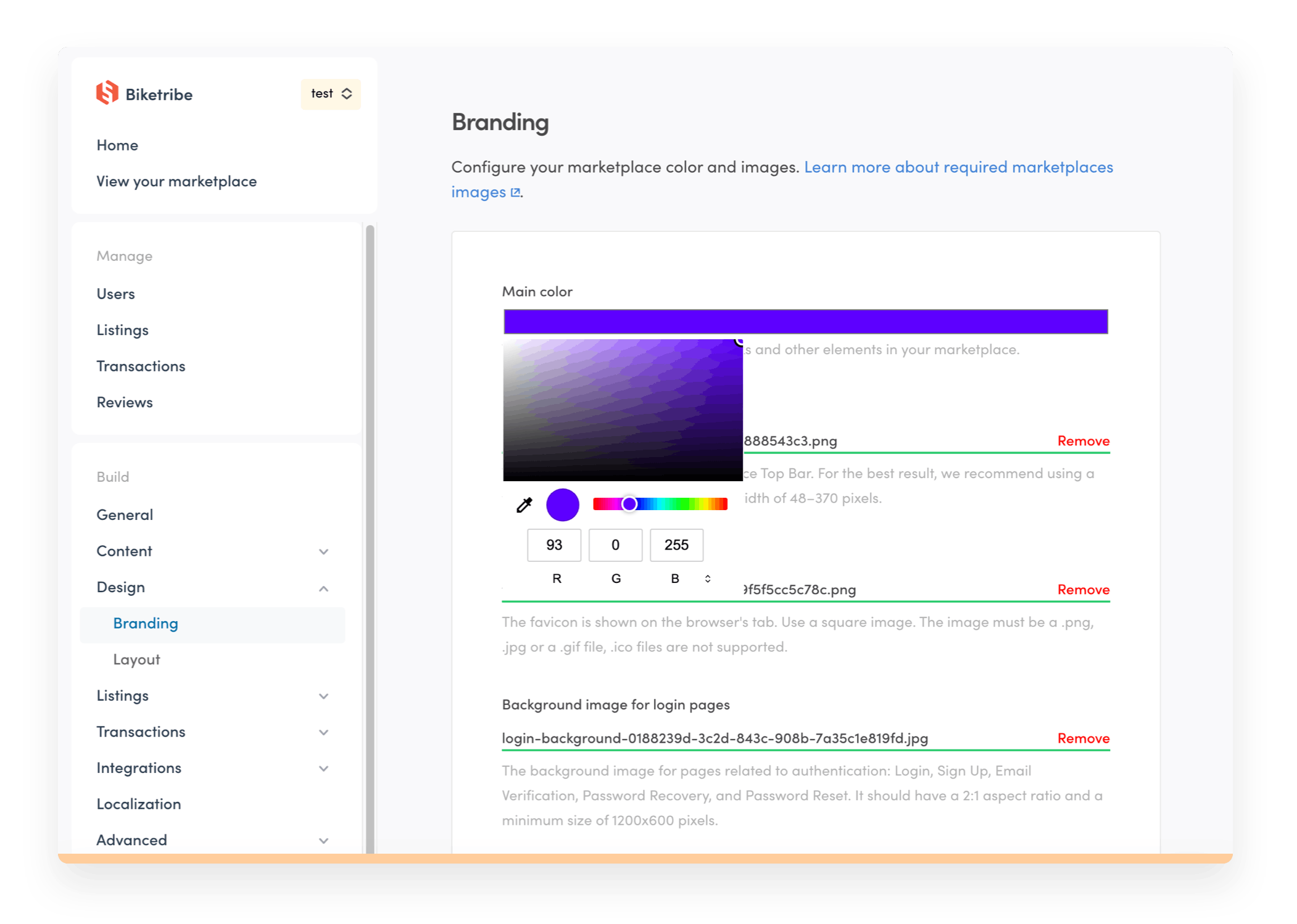
Launching a marketplace with Sharetribe is as simple as following these 10 steps:
- Create your free Sharetribe account and enter your details.
- Add your marketplace’s name.
- Build your marketplace’s landing page: add a slogan and description that explains what your marketplace does, upload visual assets, and more. Unsplash has great free images, but if you have some budget, check out Stocksy for creative, hand-selected visuals.
- Determine the design of your marketplace: upload a logo and other visual assets, and choose the layout of your search page and listing pages.
- Configure your listing settings, listing fields, and search settings.
- Choose your commission and minimum transaction size.
- Test that everything looks and works to your liking in your Test environment.
- Once everything is ready, it’s time to subscribe!
- Activate online payments by connecting a Stripe account. You’ll be able to receive payments and collect commissions straight away.
- Check everything over one last time. Congratulations! You’re ready to launch your marketplace.

When you find yourself needing these more advanced features, you can build them on top of your existing Sharetribe marketplace.
It’s possible to self-host your marketplace on Sharetribe’s headless, API-based marketplace solution. This option enables entrepreneurs to create more advanced features uniquely suited to their business while managing their marketplace in our user-friendly Console.
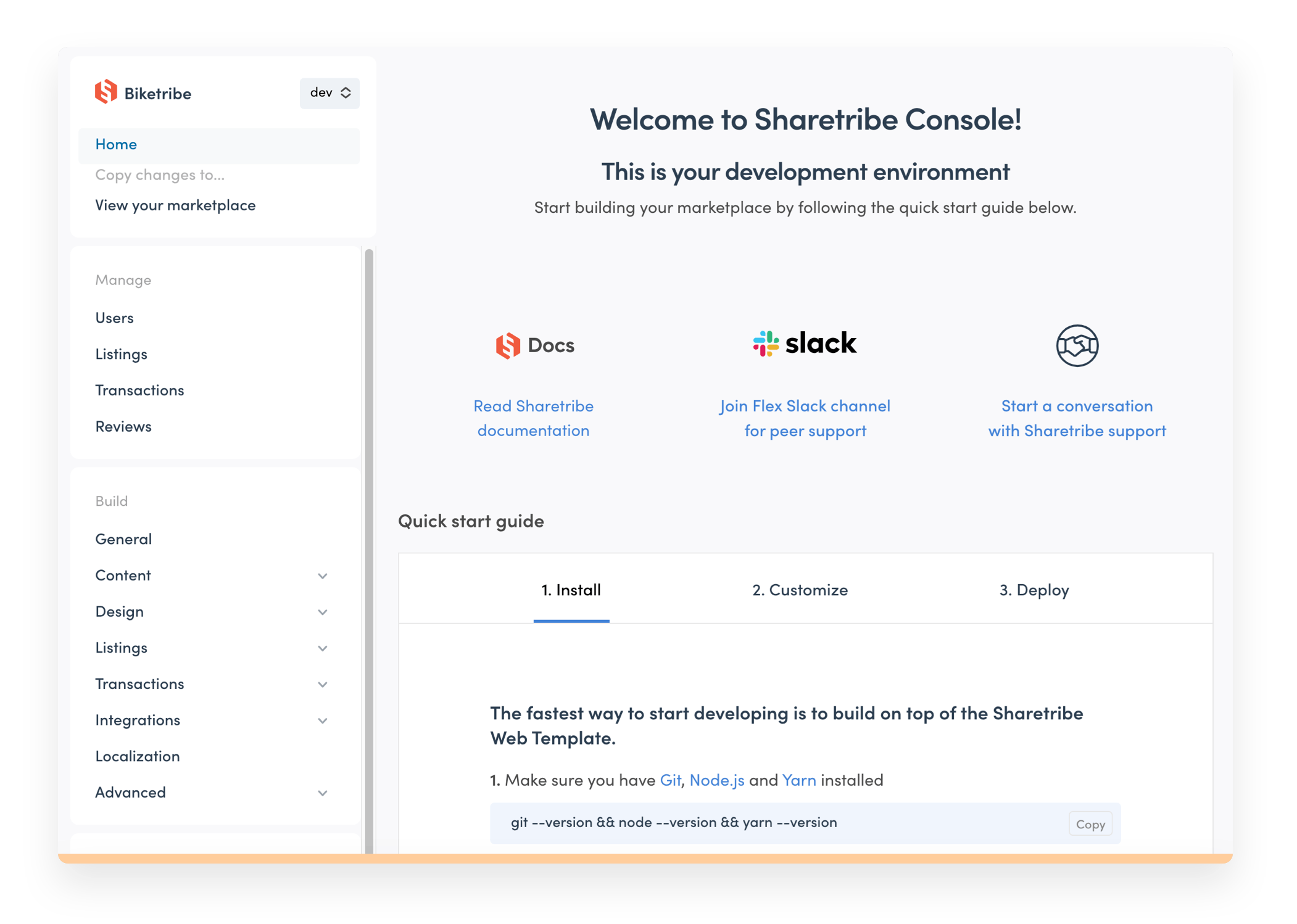
With Sharetribe, you get all fundamental marketplace functionality out of the box and customize the platform to fit your exact needs. Enjoy a world-class developer experience, or hire a Sharetribe-vetted expert to build your platform. We have helpful guides on finding the right marketplace developer and describing your marketplace requirements to get the most (and best) out of the hiring process.
Thanks to its customizability, the Sharetribe self-hosted process can be tailored to every founder and idea. But more often than not, the process follows these steps:
- Determine the custom functionality and design you want to build on top of your Sharetribe marketplace. This can be anything from a single feature to an entire custom front-end application build.
- Download Sharetribe Web Template and set up your development environment. Here’s a comprehensive guide to getting started in Sharetribe’s technical documentation. If you don’t have a developer on your team, reach out to Sharetribe’s verified Expert Partners, discuss your needs and budget, and choose the partner that’s right for you.
- Customize the Template to fit your marketplace idea and requirements.
- Set up your customized Template and launch your bespoke marketplace! 🚀
Once your marketplace is live, the sky is the limit. You can keep repeating the build-learn-improve process as your business grows.
Want to introduce multiple new transaction flows? Easy. Integrate third-party services like marketing automation, shipping providers, or user authentication? Sure! Build complete new custom features to serve your niche? Absolutely possible.
While you’re growing your business, Sharetribe continues to host your backend, take care of maintenance, security, and compliance, and introduce powerful new feature updates regularly. No matter how ambitious your goals are, you can realize them with Sharetribe.
Building a marketplace is a journey, and the first step is the most important.
Need some inspiration? Check out examples of other marketplaces built with Sharetribe or read our customer stories to learn about entrepreneurs who’ve created thriving multi-vendor businesses.
Want some marketplace business advice? Check out our complete guide on how to build a marketplace.
And if you’re still stuck? Visit Sharetribe’s Help Center. You can contact Sharetribe’s customer support team seven days a week. They’re experts on online marketplaces and will help you as you get familiar with Sharetribe and move your business forward.
Start your 14-day free trial
Create a marketplace today!
- Launch quickly, without coding
- Extend infinitely
- Scale to any size
No credit card required
